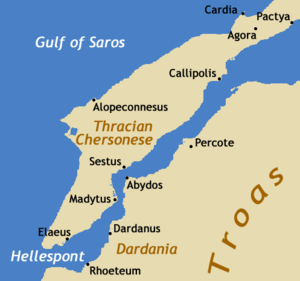Miltiades the Elder facts for kids
Quick facts for kids
Miltiades the Elder
|
|
|---|---|
| Tyrant of the Chersonese | |
| In office c. 556 BC – 525 BC |
|
| Succeeded by | Stesagoras |
| Personal details | |
| Born | c. 590 BC Athens |
| Died | c. 525 BC (aged c. 65) |
| Relations | Miltiades the Younger (nephew) |
Miltiades the Elder (born around 590 BC, died around 525 BC) was an important leader from Athens, a powerful city in ancient Greece. He belonged to a rich and famous family called the Philaids. Miltiades is best known for traveling to a place called the Thracian Chersonese, which is now known as Gallipoli in modern-day Turkey.
The local people there asked him to become their ruler, and he accepted. During his time as ruler, Miltiades built a very important defensive wall across the peninsula to protect the area.
Miltiades the Elder was also the uncle of Miltiades the Younger. His nephew became a famous military leader who played a big part in the Battle of Marathon, a major battle in ancient Greek history.
Early Life and Family in Athens
Miltiades the Elder was born in Athens around 590 BC. His father was Cypselus, who held a high position in Athens called an archon. An archon was like a chief magistrate or leader. Miltiades' family, the Philaids, was one of the wealthiest and most powerful families in Athens at that time. They even claimed to be related to the mythological king Aeacus, a hero from ancient Greek stories.
When he was young, Miltiades was a very good athlete. He owned a special chariot pulled by four horses. In 560 BC, he won a victory in the chariot race at the famous Olympic Games. This was a huge honor in ancient Greece.
Ruling the Thracian Chersonese
The Thracian Chersonese was home to a tribe called the Dolonci. They were having a tough time because their rivals, the Apsinthians, kept defeating them in battles. The Dolonci decided to seek advice from the Oracle of Delphi, a famous ancient Greek priestess who gave prophecies. The Oracle told them to find a Greek colonist to lead them back to Thrace.
On their way back through Athens, the Dolonci met Miltiades. They were impressed by how kind and welcoming he was. So, they asked him to be their new leader. Miltiades agreed to their request. Historians have different ideas about why he accepted. Some think he wanted to leave Athens because he wasn't happy with the ruler, Peisistratus. Others believe he was actually helping Athens to spread its influence in the region.
Miltiades arrived in the Thracian Chersonese with a group of Athenian settlers, probably between 556 BC and 550 BC. These settlers helped him build and strengthen the city of Cardia. Miltiades is also credited with founding several other cities in the area, such as Pactye, Agora, and Crithote.
His most famous project was building the Long Wall. This wall stretched all the way from Cardia to Pactye. It was finished quite early in his rule, likely before 546 BC. The main purpose of this wall was to keep the Apsinthians out and protect the peninsula from their attacks.
During his time as ruler, Miltiades also fought a war against the city of Lampsacus. This war didn't go very well for him. He was even captured briefly in an ambush by the Lampsacenes. However, a powerful king named Croesus of Lydia stepped in and convinced the Lampsacenes to release Miltiades without harm.
Miltiades the Elder passed away around 525 BC. He did not have any children. After his death, his nephew, Stesagoras, took over as ruler. Sadly, Stesagoras was killed by the Lampsacenes shortly after. To honor Miltiades, an annual competition of horse-racing and gymnastics was started in the Thracian Chersonese. After Stesagoras's murder, people from Lampsacus were not allowed to participate in these games.
See also
 In Spanish: Milcíades el Viejo para niños
In Spanish: Milcíades el Viejo para niños


